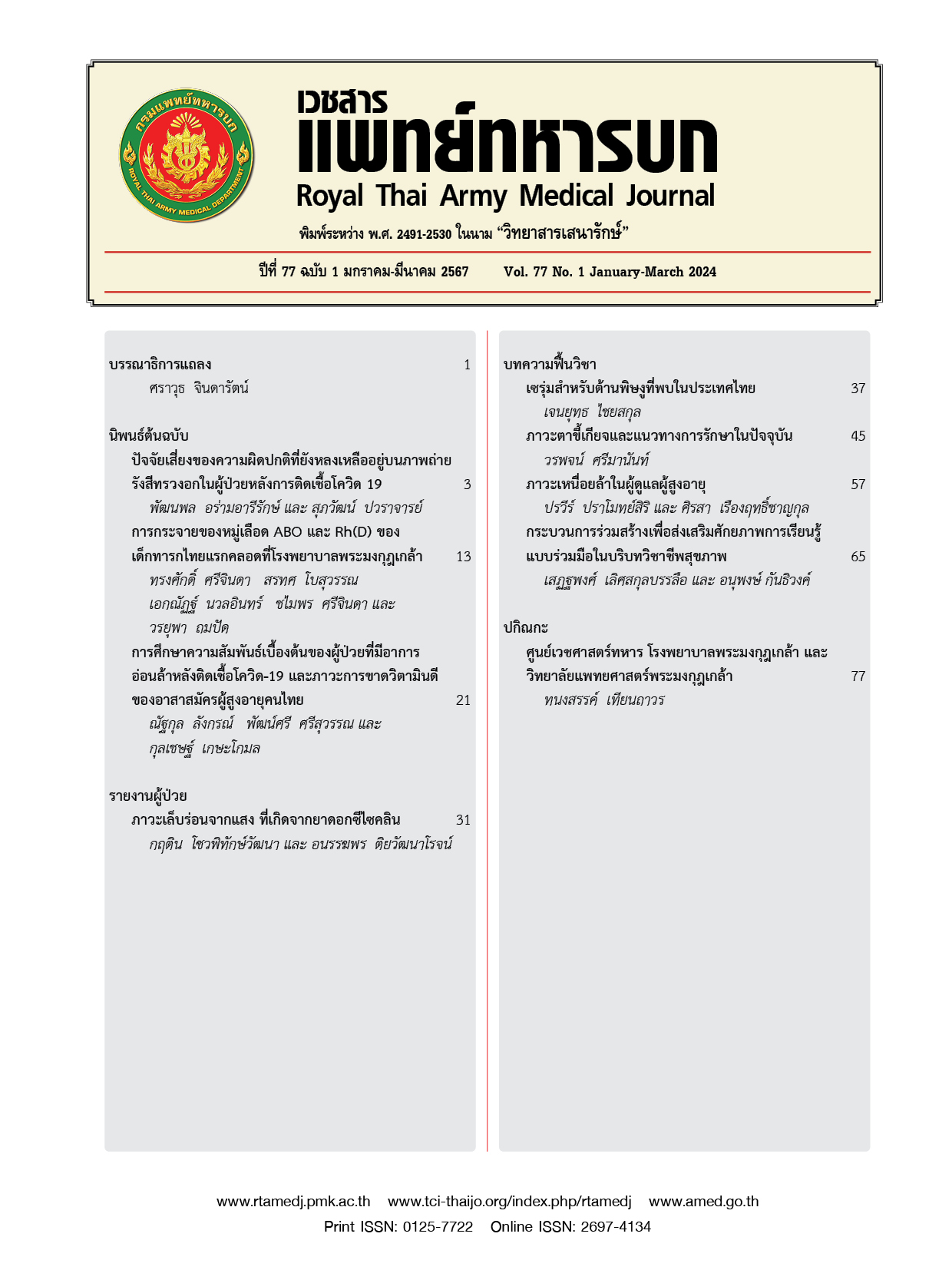กระบวนการร่วมสร้างเพื่อส่งเสริมศักยภาพการเรียนรู้แบบร่วมมือ ในบริบทวิชาชีพสุขภาพ
Main Article Content
Abstract
Downloads
Article Details

This work is licensed under a Creative Commons Attribution-NonCommercial-NoDerivatives 4.0 International License.
Articles in this journal are copyrighted by the Royal Thai Army Medical Department and published under the Creative Commons Attribution-NonCommercial-NoDerivatives 4.0 International (CC BY-NC-ND 4.0) license.
may be read and used for academic purposes, such as teaching, research, or citation, with proper credit given to the author and the journal.
Use or modification of the articles is prohibited without permission.
Statements expressed in the articles are solely the opinions of the authors.
Authors are fully responsible for the content and accuracy of their articles.
Any other republication of the articles requires permission from the journal.
References
Laal M, Laal M. Collaborative learning: what is it? Procedia Soc Behav Sci. 2012;31: 491–95.
Laal M, Ghodsi SM. Benefits of collaborative learning. Procedia Soc Behav Sci. 2012;31: 486–90.
Zhang J, Cui Q. Collaborative learning in higher nursing education: A systematic review. J Prof Nurs. 2018; 34(5):378–88.
Voorn RJJ, Kommers PAM. Social media and higher education: introversion and collaborative learning from the student’s perspective. International Journal of Social Media and Interactive Learning Environments. 2013;1(1):59.
Järvenoja H, Malmberg J, Törmänen T, Mänty K, Haataja E, Ahola S, et al. A collaborative learning design for promoting and analyzing adaptive motivation and emotion regulation in the science classroom. Front Educ (Lausanne). 2020;5:16 p.
Kassab SE, Taylor D, Hamdy H. Student engagement in health professions education: AMEE Guide No. 152. Med Teach. 2023; 45(9):949-65.
Groccia JE. What Is student engagement? New Directions for Teaching and Learning. 2018; 2018(154):11-20.
Bovill C, Bulley CJ. A model of active student participation in curriculum design: Exploring desirability and possibility. In Rust C, editor, Improving Student Learning (18) Global theories and local practices: Institutional, disciplinary and cultural variations. Oxford: The Oxford Centre for Staff and Educational Development. 2011. p. 176-88.
Varwell S. A literature review of Arnstein’s ladder of citizen participation. Exchanges: The Interdisciplinary Research Journal. 2022;10(1):108-44.
Könings KD, Mordang S, Smeenk F, Stassen L, Ramani S. Learner involvement in the co-creation of teaching and learning: AMEE Guide No. 138. Med Teach. 2021;43(8):924-36.
Harden J, Harden RM. The Changing Role of Medical Students. n.p: Elsevier; 2023.
Alan Cribb, John Owens, Guddi Singh. Co-creating an expansive health care learning system. AMA J Ethics. 2017;19(11):1099– 1105.
Cook-Sather A, Luz A. Greater engagement in and responsibility for learning: what happens when students cross the threshold of student-faculty partnership. Higher Education Research & Development. 2015;34(6):1097-109.
Murakami M, Takeuchi A, Jin S, Matoba K. Can the “Five Challenges” overcome the problem of “Reform Without Change” in medical education? Reexamining the “Hidden Curriculum”. Acta Med Port. 2023;36(9):613-4.
Bovill C. Co-creation in learning and teaching: the case for a whole-class approach in higher education. High Educ (Dordr). 2020;79(1):1023-37.
Hill J, Healey RL, West H, Déry C. Pedagogic partnership in higher education: encountering emotion in learning and enhancing student wellbeing. Journal of Geography in Higher Education. 2021;45(2019):167-85.
Ryan RM, Deci EL, editors. Self-Determination Theory: Basic Psychological Needs in Motivation, Development, and Wellness. New York, NY: Guilford Press; 2017.
Joyce DH, Megan MO. Participatory action research as a rationale for student voices in the scholarship of teaching and learning. In: Sterling V, editors. Engaging student voices in the study of teaching and learning. London: Routledge; 2009. p. 17.
Martens SE, Wolfhagen IHAP, Whittingham JRD, Dolmans DHJM. Mind the gap: Teachers’ conceptions of student-staff partnership and its potential to enhance educational quality. Med Teach. 2020;42(5):529-35.
Seale J, Gibson S, Haynes J, Potter A. Power and resistance: Reflections on the rhetoric and reality of using participatory methods to promote student voice and engagement in higher education. J Furth High Educ. 2015;39(4):534-52.
Carey P. Student as co-producer in a marketised higher education system: a case study of students’ experience of participation in curriculum design. Innovations in Education and Teaching International. 2013;50(3):250-60.
Meeuwissen SNE, Spruijt A, van Veen JW, de Goeij AFPM. Student participation in governance of medical and veterinary education: experiences and perspectives of student representatives and program directors. Adv Health Sci Educ Theory Pract. 2019;24(4):665-90.
Dai K, Matthews KE. ‘Students as partners rather than followers but …’: understanding academics’ conceptions of changing learner-teacher relationships in Chinese higher education. Higher Education Research & Development. 2023;42(6):1362-76.
Seale JK. Doing student voice work in higher education: an exploration of the value of participatory methods. Br Educ Res J. 2009;36(6): 995-1015.
Geraghty JR, Young AN, Berkel TDM, Wallbruch E, Mann J, Park YS, et al. Empowering medical students as agents of curricular change: a value-added approach to student engagement in medical education. Perspect Med Educ. 2020;9(1):60-5.
Kapadia SJ. Perspectives of a 2nd-year medical student on ‘Students as Partners’ in higher education - What are the benefits, and how can we manage the power dynamics? Med Teach. 2021;43(4):478-9
Cheng FF, Wu CS, Su PC. The Impact of Collaborative Learning and Personality on Satisfaction in Innovative Teaching Context. Front Psychol. 2021;12:713497.
Yildiz Durak H. Role of personality traits in collaborative group works at flipped classrooms. Curr Psychol. 2022:1-21.
Anderson H, Sweeney C, Perry R, Vaquero J, Ison H. Patient-centered team-based learning in pre-clinical curriculum supporting the application of knowledge to real-world clinical experience. Med Sci Educ. 2020;30(1):65-8.
Ní Chianáin L, Fallis R, Johnston J, McNaughton N, Gormley G. Nothing about me without me: a scoping review of how illness experiences inform simulated participants’ encounters in health profession education. BMJ Simul Technol Enhanc Learn. 2021;7(6):611-6.
McDonald A, McGowan H, Dollinger M, Naylor R, Khosravi H. Repositioning students as co-creators of curriculum for online learning resources. Australasian Journal of Educational Technology. 2021;37(6):102-18.


